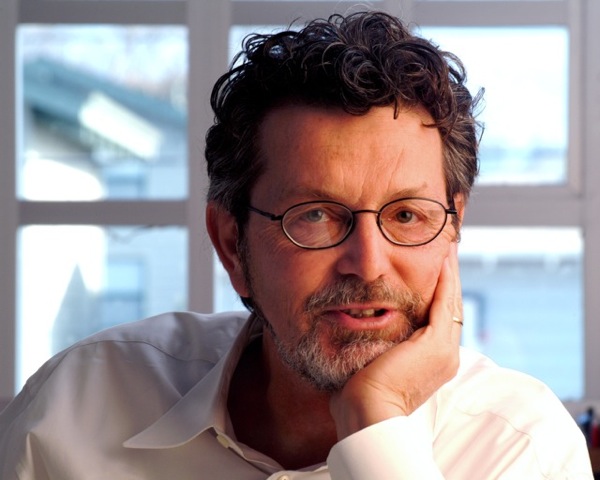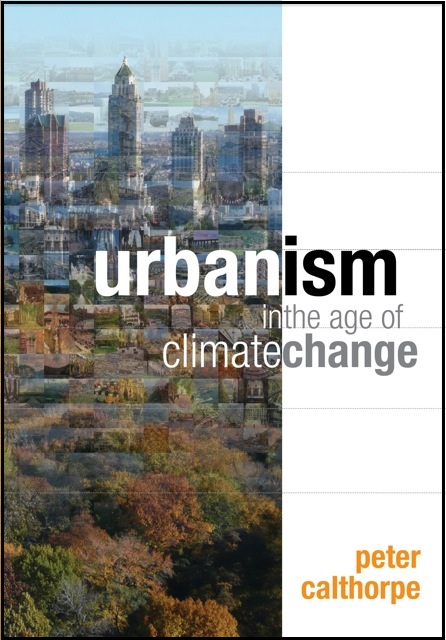 Peter Calthorpe.Cities may be the trendy topic du jour, but Peter Calthorpe has been talking about the benefits of urbanism since the 1970s. In 1993, he was one of the founders of the Congress for the New Urbanism, an influential national organization that promotes walkable, mixed-use, transit-rich development.
Peter Calthorpe.Cities may be the trendy topic du jour, but Peter Calthorpe has been talking about the benefits of urbanism since the 1970s. In 1993, he was one of the founders of the Congress for the New Urbanism, an influential national organization that promotes walkable, mixed-use, transit-rich development.
Now Calthorpe has come out with a new book, Urbanism in the Age of Climate Change. In it, he argues that sustainable urban development must play a key role in the fight to reduce carbon emissions and counter climate change. He writes:
Confronting climate change is a little like the war on drugs; you can go after to supplier — coal-fired power plants — or you can pursue the addicts — inefficient buildings and suburban sprawl. Both will be necessary.
Calthorpe’s book lays out, with convincing specificity, the cost of continuing along the path of sprawl development — in land consumption, water consumption, energy consumption, and sheer dollars spent. He also shows how much all those costs could be reduced by the implementation of what he calls “green urbanism” — simple urbanist design principles teamed with green technology and renewable energy. Using models developed as part of a land-use analysis dubbed the Vision California project, he estimates that a green urbanist scenario could mean a reduction of 43 percent in vehicle miles traveled per American household, for instance, versus the current trends. (Marianna Leuschel’s graphic design gives his arguments visual punch.)
I talked recently with Calthorpe about the role sprawl development played in the recent economic crisis, the importance of not counting solely on technology to cut greenhouse gases, and the difficulty of convincing certain environmental groups of the importance of denser development.
Q. What was the inspiration to write this particular book?
A. The inspiration was to go beyond the urban design community, and try and communicate with a larger set of stakeholders, particularly the environmental community — which I think has lost track of the notion that urbanism is probably the most cost-effective and robust solution to climate change and many other of our problems.
 Q. You talk quite a bit about design solutions vs. technology solutions — what can be done by designing the places we live differently, rather than putting an emphasis on “What’s the new electric car?”
Q. You talk quite a bit about design solutions vs. technology solutions — what can be done by designing the places we live differently, rather than putting an emphasis on “What’s the new electric car?”
A. The whole point of urbanism is that it reduces the demand on the technology. If we just posit that everybody’s going to keep driving 24-25,000 miles per household per year, the burden on electric cars and streets and parking and congestion — just the hundreds of square miles of solar farms or wind farms that we’re going to have to build — is going to be extraordinary. It’s much more cost-effective to reduce that fundamental behavior number, the amount of auto dependence we have, before we start thinking about what kind of automobiles we’re going to drive.
The same is true of energy in buildings. It’s exciting to see all the green technology that’s being applied to buildings, and it’s very, very important, but step one has got to be to build more compact buildings that inherently demand less energy to heat, cool, and light.
Q. I’m interested to know how you feel the awareness of these issues has changed over time.
A. I think the development community has really been transformed. They understand that urbanism is going to be the next generation of growth in America. That we just can’t afford, nor do we have the market demand, for more sprawl. Part of the economic collapse that we saw in ’08 was not just bad financing structures. It was that we overbuilt large-lot, single-family subdivisions. We built way too much of the wrong thing. Getting it right the next time out is going to be very important economically.
Policymakers really understand it. When they begin to drill down into any issue, whether it’s water, fiscal impacts to cities, or household budgets, they get the fact that the lifestyle we’ve been framing up was affordable to a smaller and smaller segment of the population, and perhaps more importantly, needed by a smaller and smaller segment of the population.
Environmentalists, it’s really a split group. There are some organizations like NRDC that are really clear-headed about smart growth and how important a role, almost an a priori role, that it needs to play in addressing almost all the environmental issues. But then there are groups, like Sierra Club, that can’t seem to control their chapters and end up using environmental issues as a way of opposing infill and urban development. Many other groups are focused on a single issue, like bird populations or wetlands or particular ecologies, that can’t see beyond the individual scope of their agenda. Climate change attacks all of the above, and if we don’t address climate change, saving this or that wetland is pretty much a fool’s chase.
The public at large, I think that’s a very mixed bag. There are a lot of households that really understand they can’t afford and really don’t need a large lot in the suburbs. But there are many others who just — the idea of a great urban environment, whether it’s a streetcar suburb with bungalows, or a townhouse in a walkable neighborhood, or even a condo in a real city — they don’t understand those range of choices. They haven’t had them close at hand long enough. There’s still a great need for clarity and vision to communicate that there really are more diverse choices out there that can all fulfill the American dream.
Q. Can the word urbanism — because it has urban in it, because of all the associations with that word — be problematic when communicating with the general public?
A. I think we need to rehabilitate the word urban rather than run away from it. I think people need to think long and hard about what the word urban means, because it does, and it can and it should, mean many different things in many different places. It’s not just downtown apartments and condos. It’s also townhouses in streetcar suburbs, and it’s bungalows in walkable villages.
I think New Urbanism, so criticized for doing suburban development, was right on target by helping to define a kind of suburban growth that matched a lot of household needs but still was much more environmentally sustainable than traditional sprawl. We’re criticized often for being the “New Suburbanism,” but in my mind, that’s exactly fine. We need both models for healthy suburban growth as well as models for urban infill.
Q. There’s a lot of rhetoric on the right about “we need freedom of choice, we don’t want these kinds of dense development, people are telling us what to do with our property.”
A. All you can do in that context is put out the facts. The facts, unfortunately, seem not to matter as much as the rhetoric and the story. I don’t think there’s any convincing them. The reality, however, is that providing choice in a marketplace means offering up something more than a subdivision. If we provide choice, not everybody wants to live in an apartment, not everybody wants to live in a townhouse or a bungalow, but every study done by serious economists and housing developers shows that there are huge unmet needs in those domains. As a matter of fact, the lack of choice, the fact that we overproduced large-lot, single family for the last 20 years is a big part of why we had this economic collapse.
There is a tragic amount of misinformation here. The market demands are very diverse. Good urbanism is the solution for providing for a much more diverse set of choices.
Q. If things can be framed in economic terms — not “you’re doing this to save the planet” — that gets past the ideology to a certain extent.
A. The beauty of urbanism is that it solves so many problems simultaneously. You can easily frame it as an economic solution, not an environmental solution. In doing the work for Vision California, where we posited different types of urban development futures over the next 20 and 40 years, we were able to actually calibrate and measure exactly the impacts on household budgets, on city budgets, on infrastructure costs. It’s clear that the more we sprawl, the more expensive it is for everybody. You chew up more land, you have to build more roads, string out more utilities. Sooner or later, everybody ends up paying for all that. To a certain degree, that burden is exactly what caused the housing bust. People just can’t afford that level of inefficiency.


